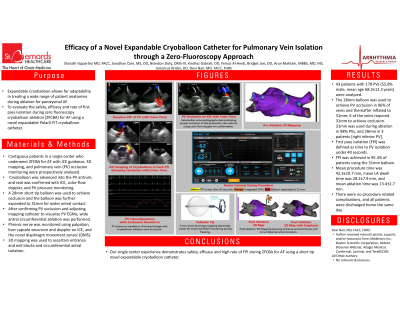Cardiac: Other
Efficacy of a Novel Expandable Cryoballoon Catheter for Pulmonary Vein Isolation through a Zero-Fluoroscopy Approach

johnathan Cain, DO – RESIDENT PHYSICIAN, INTERNAL MEDICINE, ST BERNARDS HEART AND VASCULAR; brandon Doty, OMS – Medical Student, NYITCOM; Kirollos Gabrah, DO – RESIDENT PHYSICIAN, INTERNAL MEDICINE, ST BERNARDS HEART AND VASCULAR; Feross Al-Hindi, OMS – Medical Student, NYITCOM; Bridget lee, DO – RESIDENT PHYSICIAN, INTERNAL MEDICINE, ST BERNARDS HEART AND VASCULAR; Arun Mahtani, MD – RESIDENT PHYSICIAN, INTERNAL MEDICINE, NYU; Jamarcus Brider, DO – RESIDENT PHYSICIAN, INTERNAL MEDICINE, ST BERNARDS HEART AND VASCULAR; Devi Nair, MD, FACC, FHRS – Attending Electrophysiologist, Electrophysiology, ST BERNARDS HEART AND VASCULAR
Purpose: Expandable Cryoballoon allows for adaptability in treating a wide range of patient anatomies during ablation for paroxysmal AF. To evaluate the safety, efficacy and rate of first pass isolation during zero fluoroscopy cryoballoon ablation (ZFCBA) for AF using a novel expandable PolarX FIT cryoballoon catheter,
Material and Methods: Contiguous patients in a single center who underwent ZFCBA for AF with ICE guidance, 3D mapping and pulmonary vein (PV) occlusion monitoring were prospectively analyzed. Cryoballoon was advanced into the PV antrum, and seal was confirmed with ICE, color-flow doppler, and PV pressure monitoring. The 28mm short tip balloon was used to achieve occlusion and the balloon was further expanded to 31mm for wider antral contact. After confirming PV occlusion and adjusting mapping catheter to visualize PV EGMs, wide antral circumferential ablation was performed. Phrenic nerve was monitored using palpation, liver capsule excursion and doppler on ICE, and the novel diaphragm movement sensor (DMS). 3D mapping was used to ascertain entrance and exit blocks and circumferential antral isolation.
Results: 43 patients with 178 PVs (55.8% male, mean age 68.2±12.3 years) were analyzed. The 28mm balloon was used to achieve PV occlusion in 96% of veins and thereafter inflated to 31mm; 6 of the veins required 31mm to achieve occlusion. 31mm was used during ablation in 98% PVs, and 28mm in 3 patients [right inferior PV]. First pass isolation (FPI) was defined as time to PV isolation under 40 seconds. The FPI was achieved in 95.3% of patients using the 31mm balloon, and PV EGMs were visualized during ablation in all patients using the short tip balloon. Mean procedure time was 42.3±10.7 min, mean LA dwell time was 28.2±7.9 min, and mean duration of cryo ablation was 13.4±2.7 min with zero fluoroscopy. There were no procedure related complications and all patients were discharged home the same day.
Conclusions: Our single center experience demonstrates safety, efficacy and high rate of FPI during ZFCBA for AF using a short tip novel expandable cryoballoon catheter.
Material and Methods: Contiguous patients in a single center who underwent ZFCBA for AF with ICE guidance, 3D mapping and pulmonary vein (PV) occlusion monitoring were prospectively analyzed. Cryoballoon was advanced into the PV antrum, and seal was confirmed with ICE, color-flow doppler, and PV pressure monitoring. The 28mm short tip balloon was used to achieve occlusion and the balloon was further expanded to 31mm for wider antral contact. After confirming PV occlusion and adjusting mapping catheter to visualize PV EGMs, wide antral circumferential ablation was performed. Phrenic nerve was monitored using palpation, liver capsule excursion and doppler on ICE, and the novel diaphragm movement sensor (DMS). 3D mapping was used to ascertain entrance and exit blocks and circumferential antral isolation.
Results: 43 patients with 178 PVs (55.8% male, mean age 68.2±12.3 years) were analyzed. The 28mm balloon was used to achieve PV occlusion in 96% of veins and thereafter inflated to 31mm; 6 of the veins required 31mm to achieve occlusion. 31mm was used during ablation in 98% PVs, and 28mm in 3 patients [right inferior PV]. First pass isolation (FPI) was defined as time to PV isolation under 40 seconds. The FPI was achieved in 95.3% of patients using the 31mm balloon, and PV EGMs were visualized during ablation in all patients using the short tip balloon. Mean procedure time was 42.3±10.7 min, mean LA dwell time was 28.2±7.9 min, and mean duration of cryo ablation was 13.4±2.7 min with zero fluoroscopy. There were no procedure related complications and all patients were discharged home the same day.
Conclusions: Our single center experience demonstrates safety, efficacy and high rate of FPI during ZFCBA for AF using a short tip novel expandable cryoballoon catheter.
